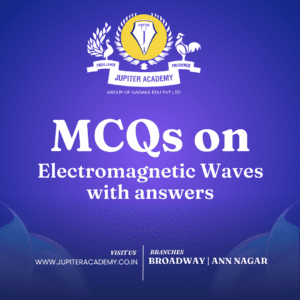Advisory and Instructions on Updation of Aadhaar Card/ UDID Card/...
Read MoreMCQ on Electromagnetic Waves
The two components of the electromagnetic wave are the electric field and magnetic field. The electric field is formed due to the flow of voltage and the magnetic field from the flow of current

Characteristics of Electromagnetic Wave
- Electromagnetic waves are transverse in nature. The electric and magnetic field are perpendicular to each other.
- Accelerated charges produce electromagnetic waves.
- These waves travel at a constant velocity of 3 x 108 m/s in a vacuum.
- Electromagnetic waves do not require a medium to travel.
- The frequency of the wave remains unchanged but wavelength changes when it travels from one medium to another.
- It follows the law of superposition.
- The oscillating electric and magnetic fields are in phase and their magnitudes have a constant ratio.
- The electric energy is equal to the magnetic energy in electromagnetic waves.
- The Poynting vector represents the energy transferred by electromagnetic waves per unit area.
NEET MCQS ON ElectroMagnetic Wave
Sure! Here are some NEET MCQs (Multiple Choice Questions) on electromagnetic waves along with their answers:
1. Which of the following statements about electromagnetic waves is correct?
A) They require a medium to propagate.
B) They are mechanical waves.
C) They can travel through a vacuum.
D) They have only longitudinal vibrations.
Answer: C) They can travel through a vacuum.
2. The speed of electromagnetic waves in a vacuum is:
A) 3 × 10^8 m/s
B) 2 × 10^8 m/s
C) 4 × 10^8 m/s
D) 5 × 10^8 m/s
Answer: A) 3 × 10^8 m/s
3. Which of the following electromagnetic waves has the shortest wavelength?
A) Radio waves
B) Microwaves
C) X-rays
D) Gamma rays
Answer: D) Gamma rays
4. Which of the following electromagnetic waves has the highest frequency?
A) Radio waves
B) Microwaves
C) Infrared waves
D) Ultraviolet waves
Answer: D) Ultraviolet waves
5. The electromagnetic waves with the longest wavelength are:
A) X-rays
B) Ultraviolet waves
C) Infrared waves
D) Radio waves
Answer: D) Radio waves
6. Which of the following electromagnetic waves is used in satellite communication?
A) Radio waves
B) X-rays
C) Gamma rays
D) Infrared waves
Answer: A) Radio waves
7. The electromagnetic waves that have the highest energy are:
A) Radio waves
B) Infrared waves
C) Ultraviolet waves
D) Gamma rays
Answer: D) Gamma rays
8. Which of the following statements about the polarization of electromagnetic waves is correct?
A) Electromagnetic waves are always polarized.
B) Only transverse waves can be polarized.
C) Only longitudinal waves can be polarized.
D) Electromagnetic waves cannot be polarized.
Answer: B) Only transverse waves can be polarized.
9. Which of the following electromagnetic waves is commonly used in medical imaging?
A) Radio waves
B) X-rays
C) Infrared waves
D) Ultraviolet waves
Answer: B) X-rays
10. The electromagnetic waves used in remote control devices for TVs and other appliances are:
A) Radio waves
B) Microwaves
C) Infrared waves
D) Ultraviolet waves
Answer: C) Infrared waves
Remember to consult other resources and study materials to prepare comprehensively for your NEET exam.
JEE MCQS ON ElectroMagnetic Wave
Sure! Here are some multiple-choice questions (MCQs) on electromagnetic waves with answers:
1. Which of the following statements about electromagnetic waves is true?
a) They require a medium to propagate
b) They consist of only electric fields
c) They can travel through vacuum
d) They have a higher speed than sound waves
Answer: c) They can travel through vacuum
2. The wavelength of an electromagnetic wave is:
a) The time taken for one complete cycle of oscillation
b) The distance between two consecutive crests or troughs
c) The displacement of the medium from its equilibrium position
d) The amplitude of the wave
Answer: b) The distance between two consecutive crests or troughs
3. Which of the following electromagnetic waves has the highest frequency?
a) Radio waves
b) Microwaves
c) X-rays
d) Infrared waves
Answer: c) X-rays
4. Which of the following electromagnetic waves has the shortest wavelength?
a) Ultraviolet rays
b) Infrared waves
c) Gamma rays
d) Radio waves
Answer: c) Gamma rays
5. The speed of electromagnetic waves in a vacuum is approximately:
a) 3 x 10^8 m/s
b) 3 x 10^6 m/s
c) 3 x 10^10 m/s
d) 3 x 10^4 m/s
Answer: a) 3 x 10^8 m/s
6. Which of the following colors of visible light has the highest frequency?
a) Red
b) Blue
c) Green
d) Yellow
Answer: b) Blue
7. Which electromagnetic wave is commonly used in communication systems?
a) Infrared waves
b) Ultraviolet rays
c) X-rays
d) Radio waves
Answer: d) Radio waves
8. Electromagnetic waves are produced by:
a) The flow of electric current
b) The motion of objects
c) Vibrating particles
d) Oscillating electric and magnetic fields
Answer: d) Oscillating electric and magnetic fields
9. Which of the following is not an example of an electromagnetic wave?
a) Sound wave
b) Visible light
c) Radio wave
d) X-ray
Answer: a) Sound wave
10. Electromagnetic waves can be characterized by their:
a) Amplitude and frequency
b) Wavelength and speed
c) Energy and polarization
d) All of the above
Answer: d) All of the above
These questions cover various aspects of electromagnetic waves and their properties. Make sure to consult your physics textbook or reference material for further study and understanding.
NEET 2025: OMR Sheet Filling Tips to Avoid Mistakes
NEET 2025: OMR Sheet Filling Tips to Avoid Mistakes Preparing...
Read MoreTN Medical 2024 Counseling: Extension of Round 2 for MBBS & BDS
TN Medical 2024 Counseling: Extension of Round 2 for MBBS...
Read MoreMCQ on Electromagnetic Waves MCQ on Electromagnetic Waves MCQ on Electromagnetic Waves MCQ on Electromagnetic Waves MCQ on Electromagnetic Waves MCQ on Electromagnetic Waves MCQ on Electromagnetic Waves MCQ on Electromagnetic Waves MCQ on Electromagnetic Waves MCQ on Electromagnetic Waves




